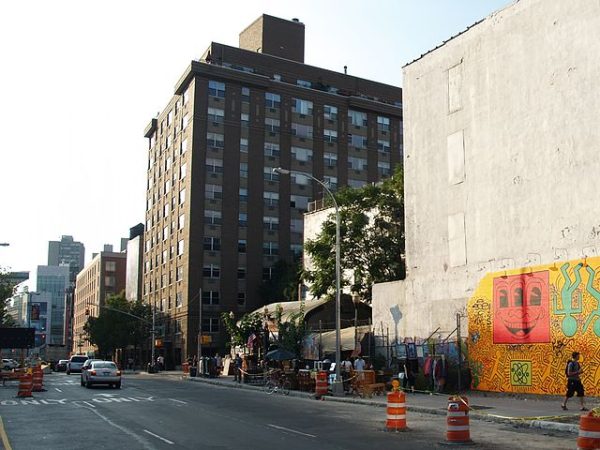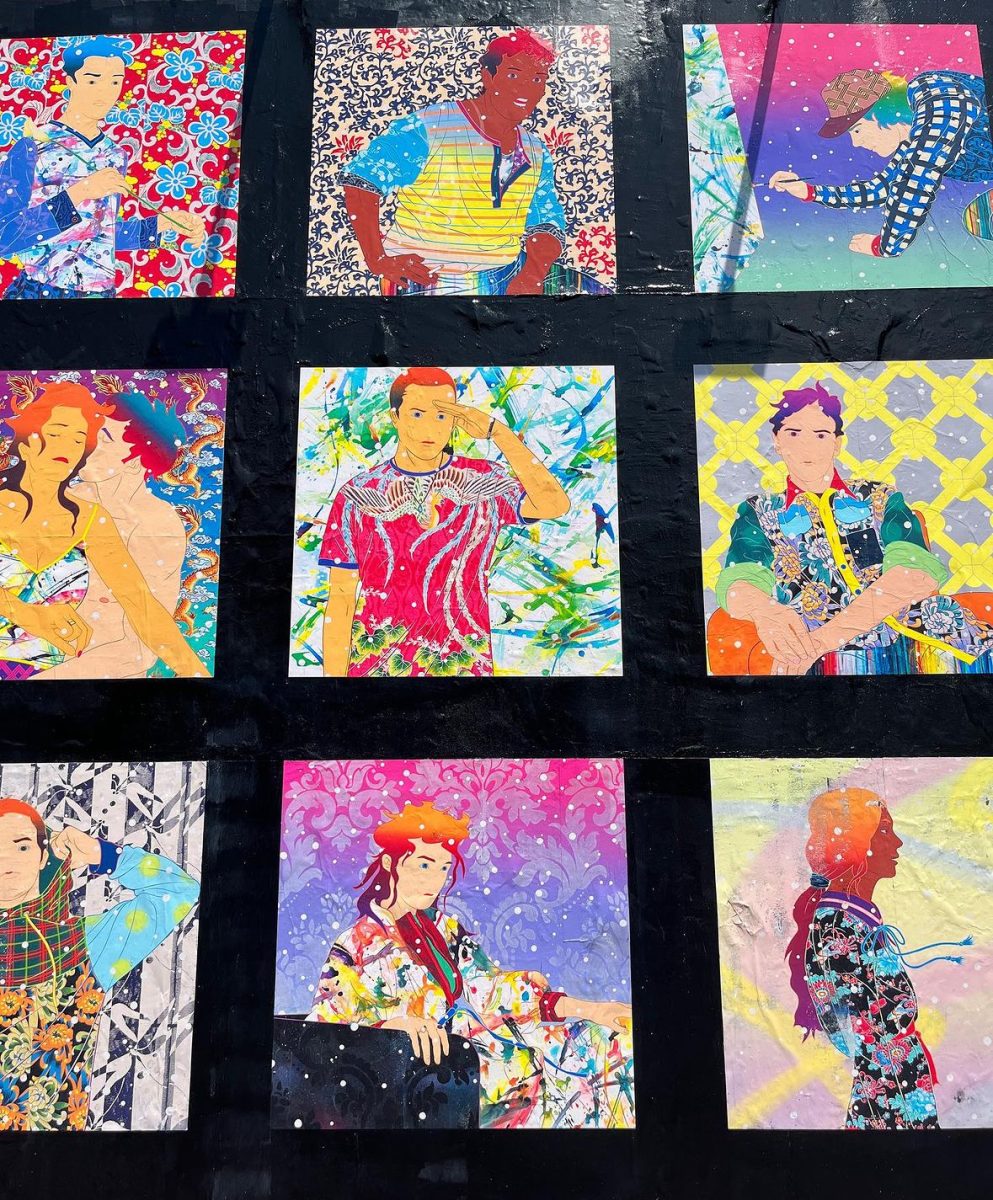In the early 1980’s, Keith Haring began the unconventional practice of public art, transforming the New York City subway’s unused advertising panels into series of chalk drawings. The continuous repetition of stylized shapes, with its bold outlines and vibrant colors, became a familiar sight to New York commuters.
As the contemporary artist grew in notoriety, Haring began to seek new, spontaneous canvases. In 1982, Haring brought chalk and paint to a cement wall on the corner of Houston and Bowery. Within days, the wall became a bright orange mural of neon green breakdancers and atomic mushroom clouds. Although not completely evident, Haring’s work both represented the empowering joy found in New York’s gay scene, and warned of imminent dangers by nuclear accidents.
At the time, Haring’s mural was the newest, and arguably most emblematic, addition to the then explosive downtown art scene. Often referred to as the “stuff of legends,” the 1980’s East Village art movement was fueled by a diverse group of misfit and rebel artists, characterized by their defiant social commentary through graffiti, collages, and sculptures. Although the movement eventually met its decline, the Bowery Wall became a lasting symbol of its exhilarating and groundbreaking essence.
Birth of the Bowery Wall
In 1984, the SoHo neighborhood began to undergo significant development, under the direction of Goldman Properties. The prominent property development company acquired the Bowery Wall during this process, and decided to preserve Haring’s mural for a few more months as part of their campaign to invest in and directly bolster the art community.
In 2008, nine years after Haring’s death, Goldman Properties and the Keith Haring Foundation honored the artist’s legacy by commissioning a local painter to recreate his 1982 piece. The recreation graced the wall for six months. Since then, Goldman Properties, under the creative direction of Tony Goldman and his daughter Jessica Goldman, continued to commission the designs of diverse artists. “It’s important to me and my family to infuse beauty into the world, infuse creativity into the world, and push the envelope,” said Jessica Goldman. It was then that the Bowery Wall Mural was born.

The Mural’s Decline
The wall’s origins lie with Keith Haring’s vandalism of public property. Thus, it was no surprise that these illegal acts would continue during its lifetime.
Throughout the years, the murals of respected artists became the working grounds for various American graffiti crews. “It was like the streets had taken over,” recalled Olivia Flores, whose husband and collaborator David Flores’ flowery, red mural of a motorcycle was the last formally commissioned piece to adorn the wall.
Initially, Flores and other commissioned artists embraced the tags of graffiti crews, deeming it as an exchange of conversation – the heart of public art. However, when the wall was relentlessly assaulted with fire-extinguisher spray-paint, the act of expression became one of pure vandalism.
OPTIMONNYC, a graffiti artist and Chelsea native, said “I think the younger generation of graffiti writers give more props to each other for going over murals — it’s a shortcut for getting fame… Graffiti no longer respects murals like it used to. I think that happened within the past ten years.”
The rising tensions surrounding the Bowery Wall began to shroud its core mission of celebrating artists and providing authentic pieces for public embrace. Subsequently, in October 2021, Jessica Goldman decided to pause curation in an attempt to salvage the wall’s legacy. “But over the last few months the tagging has become worse than ever…it totally crossed the line … It is beyond disappointing. It is a violation of something sacred,” she said.
Enter Tomokazu Matsuyama
Tomokazu Matsuyama, known professionally as “Matsu,” is a Japanese-American contemporary artist. Matsu was born in Hida Takayama, a city located in the heart of the Japanese alps. Hida Takayama, although sparsely populated, is home to Japan’s master craftsmen and carpenters, known as “Hida no takumi.” Thus, the region is highly regarded for its rich history of craftsmanship – ceramics, papercutting, kimono-dyeing, woodcarving, and lacquerware.
Despite this, Matsu’s transformative encounters with creative aesthetics only occurred after his family moved to Orange County, California. At eight years old, Matsu became infatuated with California’s thriving skate-scene. “I was always trying to copy those skate decks and those influences that I had…it just very naturally grew, and I kept drawing and drawing,” he said. Matsu believed his new interest was a manifestation of the cultural shock of being exposed to the animated DIY spirit of skateboard culture after spending his childhood in an isolated region of Japan deeply rooted in traditional practice.
Three years later, Matsu and his family returned to Japan. The transition was difficult for the eleven-year old, who had become deeply immersed in American culture. His interest in heavy metal, skateboarding, and drawing proved a stark contrast to Japan’s conservative culture. Matsu felt restricted by the firm administration of Japanese schools, as rules requiring buzzed hair and school uniforms left little room for expression. To make matters worse, not only did he feel the contrast between his American identity and Japanese norms, but his peers noticed it as well, leaving him victim to teasing and estrangement.
As Matsu entered his adolescence, his interest in skateboarding adjusted to suit the mountainous nature of Hida Takayama, blossoming into a passion for snowboarding. After graduating from a Japanese boarding school, Matsu pursued a degree in Business Management at Tokyo’s Sophia University. The flexible program allowed him time to pursue a snowboarding career between his junior and senior year. During this time, Matsu returned to America periodically to attend snowboarding camps. However, his snowboarding career came to an abrupt end when he injured his ankle in a training accident.
The 21-year-old, then in his last year of college, decided to explore graphic design, enrolling himself in night school to learn the art. Following his graduation, Matsu made the decision to continue pursuing design. The up-and-coming graphic designer moved to New York in 2002, and later received his MFA in Communications Design from Pratt Institute.
Tomokazu Matsumaya and the Bowery Mural
In 2019, Matsumaya was commissioned to create his first Bowery Mural.
“Matzu is an artist that we have been eyeing for a long time…we knew we were going to give him this wall eventually…we felt it was his time,” said Shantelle Rodriguez, one of Goldman Properties’ past creative directors.
Over the short course of two weeks, Matsu worked with a team of twelve individuals to install the 18 by 60 foot mural. Working 12 to 16 hour days, Matsu brought a different approach to installing murals, using highly detailed fine art techniques. “In this case a lot of street artists would use spray cans. I am bringing in a lot of materials that you are not supposed to use in an exterior setting like markers, lots of stenciling, pouncing (transferring an existing sketch to a specific scale)…I bring in everything. Acrylic paint, oil paint, markers, stenciling; and with the compilation of all that will come one strong, intense imagery,” Matsu said.
By the end of the installation process, the wall featured sprawling leaves of green to yellow ombre, faceless figures, dainty cherry blossoms, overlapping textile patterns, and odd neon geometric shapes. With excerpts of a Japanese garden scene surrounding a New York City subway car, Matsu’s contemporary design melds Japanese and American emblems in a vibrant exploration of New York City’s diversely global culture.
In the fall of 2023, Matsu returned to the wall. Following Jessica Goldman’s decision to halt curation on the Bowery wall, local graffiti crews took over in interim. “Since last fall, witnessing the decline of this wall and our city, has been disheartening. This recent downturn motivated me to take the initiative to breathe new life into the project,” said Matsu.
His new mural features thirty portraits: everyday New Yorkers, cultural icons from magazines, scenes from movies, and people Matsu has photographed over his two decades living in New York. The piece, entitled ‘Color of the City’, explores New York’s nature as a city of dualities— love versus hate, acceptance versus disapproval, and acknowledgment versus rejection. Yet, its diversity and challenging spirit offer opportunities for everyone to explore. Matsu said, “I wanted to encapsulate that spirit, as a way of giving back to the city. I trust New York sees this as an act of passion and dedication.” Matsu’s work marks a brighter outlook for the Bowery Mural, and encourages a renewed respect for public art installations.
With excerpts of a Japanese garden scene surrounding a New York City subway car, Matsu’s contemporary design melds Japanese and American emblems in a vibrant exploration of New York City’s diversely global culture.

